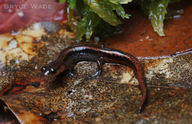|
Eurycea sphagnicola Wray, Means & Steppan, 2017
Bog Dwarf Salamander | family: Plethodontidae subfamily: Hemidactyliinae genus: Eurycea |
| Species Description: Wray KP, Means DB, Steppan SJ. 2017. Revision of the Eurycea quadridigitata (Holbrook 1842) complex of dwarf salamanders (Caudata: Plethodontidae: Hemidactyiinae) with a description of two new species. Herpetological Monographs 31:18-46. | |
 © 2022 Bryce Wade (1 of 2) |
|
|
|
Description The heads of E. sphagnicola larvae appear rounded from a dorsal view and protuberant in a lateral view. The ventral fin inserts around the anterior third of the tail, and the dorsal tail fin inserts above the cloaca (Wray et al. 2017). DIAGNOSIS: Eurycea salamanders can be differentiated from all other plethodontid salamanders in the United States except Hemidactylium scutatum because it has four digits on the hindlimb (as opposed to five digits in all other species). Furthermore, H. scutatum lacks basial constriction of the tail and has a white venter with black spotting instead of the yellow smudging in E. sphagnicola. Eurycea sphagnicola is unique from other members of the E. quadridigitata complex (E. chamberlaini, E. hillisi, E. paludicola, and E. quadridigitata) by several minor morphological differences such as the dorsal fin insertion point is above the cloaca in larvae and the average total body size is smaller than the averages of other species. However, these differences are very minute and genetic analysis is the only accurate way of differentiating them from other species of Eurycea (Wray et al. 2017). COLORATION: In life, the dorsal side of E. sphagnicola has a tannish color on the head that becomes more coppery-orange towards the posterior end. Light gray flecks are concentrated in the eye and snout regions. A dark vertebral line can be seen along the vertebral column and is darkest just above the cloacal region. The dark line fades to a series of spots after the cloaca and is absent from the tail itself. The ventral coloration is white with light yellow smudging between the cloaca the first two-thirds of the tail. The last third of the tail is a light gray. The limbs have a tan background with darker spots on the dorsal side and are completely white on the ventral side. In preservation, the dorsal coloration fades to a tannish-gray color and the darker markings become fainter. The ventral coloration becomes a cream color that lacks the yellow pigmentation E. sphagnicola has in life (Wray et al. 2017). In life, larval E. sphagnicola have a brown dorsal surface with yellow flecks. The ventral surfaces are yellowish with dark melanophore suffusions. The limbs are dark brown to almost black with minimal yellow flecks. The posterior regions of the body and tail have large irregular yellow spots that become smaller and dense at the end of the tail. The tail fins have dark mottling and small transparent flecks that become larger spots at the end of the tail. The iris is gold with a horizontal black bar (Wray et al. 2017). Distribution and Habitat Country distribution from AmphibiaWeb's database: United States U.S. state distribution from AmphibiaWeb's database: Alabama, Florida
Life History, Abundance, Activity, and Special Behaviors Eurycea sphagnicola can be found in the same locality, but different microhabitats, as E. quadridigitata in western Mississippi and the western Florida pandhandle. Eurycea sphagnicola also likely shares localities with E. paludicola in Mississippi (Wray et al. 2017). Trends and Threats Possible reasons for amphibian decline General habitat alteration and loss Comments Eurycea sphagnicola is thought to have diverged from other species in the complex 27 – 15 million years ago and may be an intermediate transition between the lotic breeding preference of most Eurycea and lentic breeding preferences of members of the E. quadridigitata complex (Wray et al. 2017) ETYMOLOGY: The specific epithet “sphagni-” is derived from the generic name of sphagnum moss. With the Latin suffix “-cola", which means “inhabitant, dweller ”, this name is a reference to the species being found on sphagnum moss in seepage bog areas (Wray et al. 2017). OTHER INTERESTING COMMENTS: Eurycea sphagnicola was previously considered to be a color morph of E. quadridigitata before its elevation to full species in 2017 (Wray et al., 2017).
References
Wray, K.P., Means, D.B., Steppan, S.J. (2017). "Revision of the Eurycea quadridigitata (Holbrook 1842) complex of dwarf salamanders (Caudata: Plethodontidae: Hemidactyliinae) with a description of two new species," Herpetological Monographs, 31(1), 18-46. [link] Originally submitted by: Nicole Yuri Kim (2022-01-31) Description by: Nicole Yuri Kim (updated 2022-01-31)
Distribution by: Nicole Yuri Kim (updated 2022-01-31)
Life history by: Nicole Yuri Kim (updated 2022-01-31)
Trends and threats by: Nicole Yuri Kim (updated 2022-01-31)
Comments by: Nicole Yuri Kim (updated 2022-01-31)
Edited by: Ann T. Chang and Ash Reining (2022-01-31) Species Account Citation: AmphibiaWeb 2022 Eurycea sphagnicola: Bog Dwarf Salamander <https://amphibiaweb.org/species/8646> University of California, Berkeley, CA, USA. Accessed May 5, 2025.
Feedback or comments about this page.
Citation: AmphibiaWeb. 2025. <https://amphibiaweb.org> University of California, Berkeley, CA, USA. Accessed 5 May 2025. AmphibiaWeb's policy on data use. |


 Map of Life
Map of Life